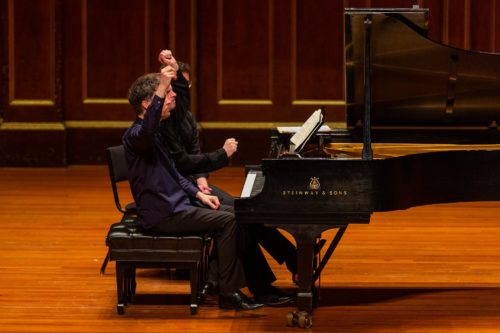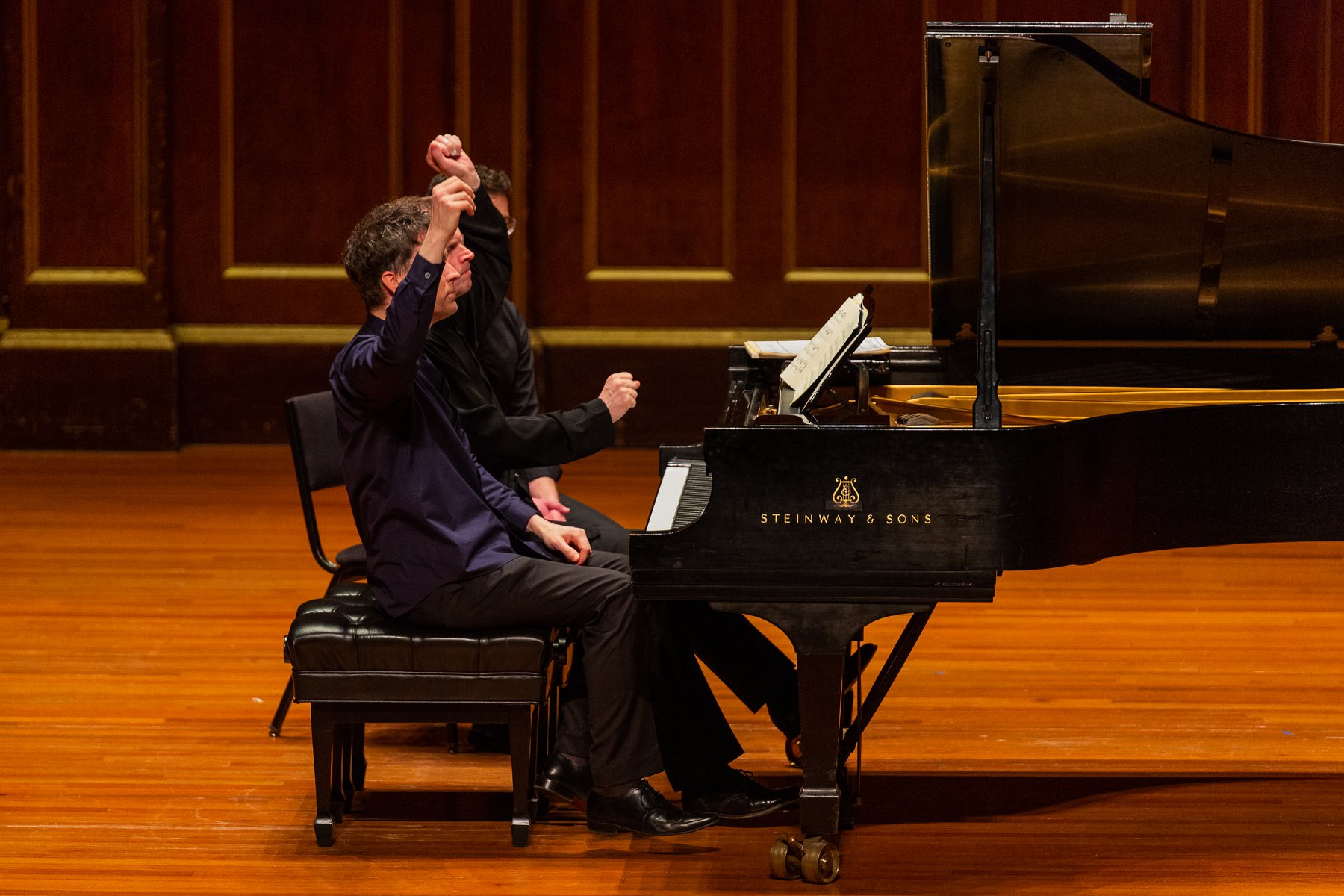 Canada Various composers: Paul Lewis and Steven Osborne (piano). Vancouver Playhouse, Vancouver, 23.2.2020. (GN)
Canada Various composers: Paul Lewis and Steven Osborne (piano). Vancouver Playhouse, Vancouver, 23.2.2020. (GN)

Fauré – Dolly Suite Op.56
Poulenc – Sonata for Piano Four Hands (1918; rev. 1939)
Debussy – Six épigraphes antiques; Petite Suite
Stravinsky – Trois pièces faciles
Ravel – Ma mère l’oye
This event was an absolute delight. Paul Lewis and Steven Osborne have given Vancouver memorable concerts on their own, but putting them together in a four-hand recital of French music was certainly a new idea. With Osborne’s commitment to the modern repertoire, a French programme seemed right up his alley, though not necessarily for Lewis, whose explorations have seldom ventured beyond Beethoven and the German masters. Their collaboration turned out to be pure magic, the softer lyrical sensitivity of the latter pianist meshing with the sharper, more jeweled articulation of the former. The results were astonishingly idiomatic. Fauré’s Dolly Suite and Ravel’s suite from Ma mère l’oye were beautiful, full of concentration and feeling. The smaller makeweights provided the right balance in the recital, showing off the artists’ keen ingenuity and coordination in a more playful way. For both pianists, it was a great way to move forward from their inspired Schubert CD collaboration of a decade ago.
It is a testimony to how carefully the artists listened to each other that their balance seemed almost identical no matter who assumed the primo position on the piano. Lewis started there in the Dolly Suite, and his freshness and natural sensitivity were evident in the opening Berceuse. The piece came off like spring water in its melancholic refinement and ease. Rhythmic playfulness then came into full display in the contrasting ‘Mi-a-ou’ and ‘Kitty-Valse’. It was the awareness of the child-like innocence in the pieces, and the carefree delight implied, that made this performance special. The intimate scale of the playing was perfect, and ‘Le Jardin de Dolly’ and ‘Tendresse’ were touching.
If anyone can change a mood, it is Poulenc. Here it was Osborne’s turn to play the top, and he brought a hard-hitting rhythmic insistence to the delightful banality of the composer’s Sonata for Piano Four Hands. Stravinsky-like wit dominated the opening movement, but was balanced with some beautifully light playing from the partners later on. Visually, the most riveting (and funny) moment came when the two pianists chased each other in their frenzied runs up and down the keyboard – exactly the cheeky effect that the composer wanted.
I have seldom heard such a devoted treatment of Debussy’s Six épigraphes antiques. The first pieces had lovely suspension and stillness at the softest volumes, fully realizing their meditative design. The pianists made the gradually mutating settings seem timeless in their motion, something I recall from Osborne’s penetrating ‘Le Gibet’ (in Gaspard de la Nuit) a few years ago. The richer colouring of the later pieces found strong detailing and heightened sensuality, notably in ‘Pour l’égyptienne’. What impressed throughout was the concentration of the playing, while leaving room for each pianist to express his own tonal character.
The second half of the concert developed in parallel to the first, with Debussy’s lovable Petite Suite to begin, Ravel’s radiant Ma mère l’oye at the end and a sharper Stravinsky piece in between. True Gallic spirit informed the Debussy. ‘En bateau’ and ‘Cortège’ were exquisite, always conveying a feeling of discovery, while the closing ‘Ballet’ was charming, with both pianists knowing just how to relax their phrases idiomatically. Stravinsky’s Trois pièces faciles (1914-1915) renewed the period flavour and tongue-in-cheek tone of the previous Poulenc, giving the artists another opportunity to relish the fun of playing together in pieces that require wit and mobility.
Ravel’s Ma mère l’oye was the highlight, with remarkable repose and refinement in its evolving textures. Lewis took the primo position, and one marvelled at the extent of genuinely quiet, concentrated playing that came forth at the deliberate tempos chosen. Once again, it was the sense of innocence and tenderness that permeated the early pieces, extending through ‘Laideronnette, impératrice des pagodes’, which had lovely colour and the mood of child’s play. But there was wit too: for example, the famous passage where Osborne’s cheeky bottom jabs duplicated the contrabassoon in the orchestral version. The final two pieces unfolded with wonder and suspension, managing to be both intimate and sensual while never forgetting the vulnerability. ‘Le jardin féerique’ was mesmerizing in the way it built so quietly and inexorably to its celestial reaches. At the close, one observed how Osborne supplied the grand rhythmic spikes on the bottom while, up top, Lewis conveyed all the feeling in these final moments.
Throw away any doubts one might have had about how successful these pianists would be in this repertoire: when two extraordinarily intelligent and sensitive artists come together, you can have magic in any repertoire. It was the thoughtfulness and imagination of Lewis and Osborne that left an imprint and made the concert one to cherish. They will now be recording this delightful programme for Hyperion.
Geoffrey Newman
Previously published in a slightly different form on http://www.vanclassicalmusic.com.
